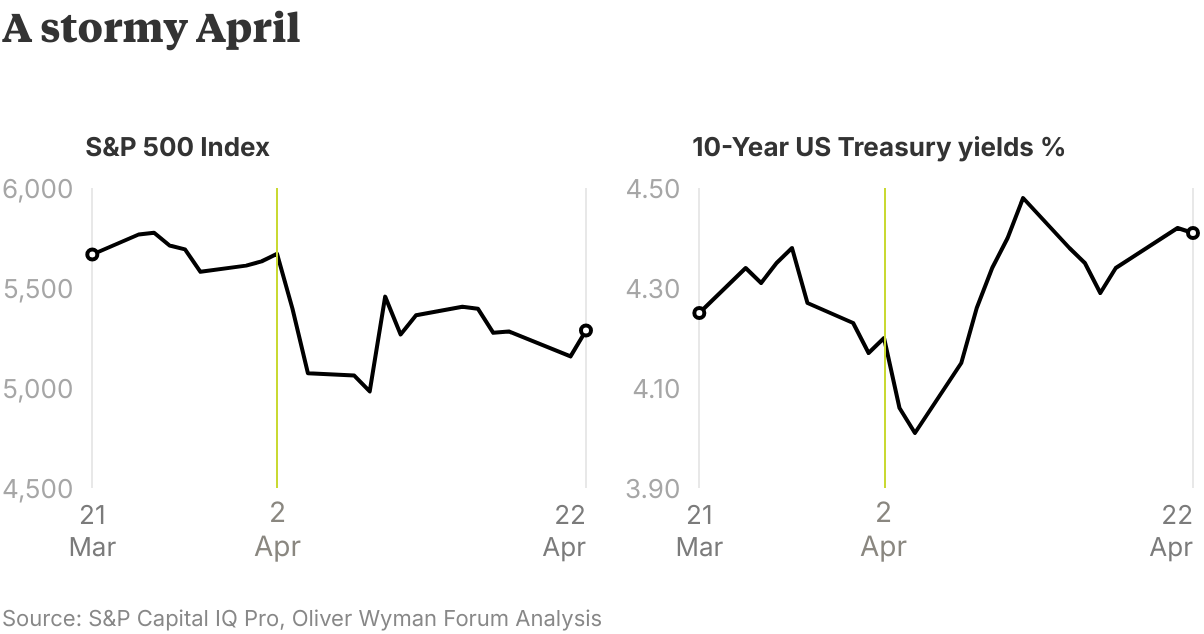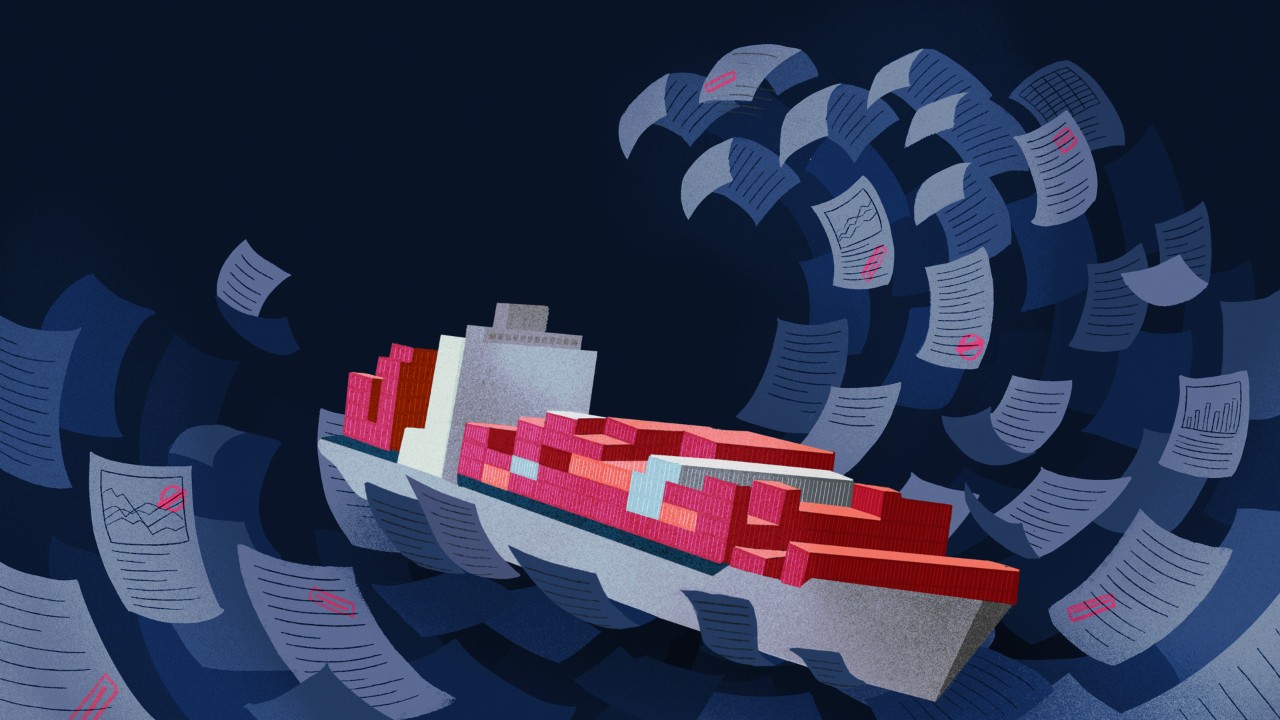The global economy won a reprieve after the United States paused much of its new tariff program for 90 days, but business leaders can’t afford to relax. They can use this time to double down on reducing their global supply chains’ exposure to tariffs and preparing for the potential of higher costs and renewed trade turmoil in the months ahead.
Markets jumped immediately after the pause but volatility persisted, underscoring that we are living in a geopolitics-first world in which the rules of the game can change with stunning speed. The latter point was driven home when the US administration said imports of smartphones and other electronic equipment would be exempt from tariffs, only for officials to say the reprieve was temporary. The administration sent similar mixed signals about tariffs on auto imports. But it went ahead with its threat to raise levies on Chinese goods to 145%.
The flurry of activity and uncertainty about when and where tariffs might settle whipsawed financial markets and shook business and consumer confidence. The University of Michigan’s Consumer Sentiment index dropped to its second-lowest level in nearly three-quarters of a century, while the International Monetary Fund sharply cut its forecasts for US and global growth this year, citing the "major negative shock" of tariffs.

No business is immune to these ructions, and leaders need to be proactive in assessing risks and mitigating them wherever possible.
Identify supply-chain vulnerabilities
Decades of trade liberalization enabled companies to extend their supply chains around the world in search of the optimum combination of price and quality. Getting a grip on those exposures is the first step to reducing risk in a deglobalizing world.
Technologies like geospatial intelligence and network mapping AI enable companies to trace trade connections beyond direct suppliers to reach deep into second- and third-tier sources. Combining that information with spending data can quantify the risk exposure in dollars and simulate the impact of any additional actions in the weeks and months ahead.
Move from transparency to mitigation
With key risks identified, companies can employ a number of strategies to reduce their exposure to tariffs.
They can strengthen forecasting to minimize the holding of excess inventory, negotiate tariff cost-sharing agreements with suppliers, and renegotiate terms such as minimum order quantities to gain greater flexibility to respond to future policy changes. Companies also can consider changing in-house production locations or shifting to contract manufacturing to reduce tariff exposure.
Other strategies include tariff engineering, which can reduce duty rates through product reclassification. Companies also need to think flexibly about pricing, considering increases where market demand allows and perhaps accepting lower margins where customer retention is a priority.
None of this will be quick or easy. The average global automaker has about 18,000 suppliers, for example. Asia’s manufacturing scale, particularly in China and Vietnam, will be difficult to replace. And reshoring significant production to the United States — or reorienting trade to other markets, as European leaders have suggested — is likely to take years. That’s why companies need to act now to decrease their tariff exposure and increase flexibility.
For people living in low- and middle-income countries, accessing healthcare can be a daily struggle with life-or-death consequences. Preventable diseases like respiratory infections, malaria, and tuberculosis account for eight of the top 10 causes of death in those regions, according to the World Health Organization.
While that’s a somber outlook, promising digital solutions are increasingly making a difference. Digital health technologies like telemedicine, mobile health apps, and electronic health records can increase access to care and drive improvements in care delivery. Success stories are already playing out around the world. For example, text message interventions for pregnant women increased prenatal visits by 174% across several developing nations.
In tuberculosis management, the 99DOTS program leverages mobile phones to track and boost medication adherence at a fraction of traditional costs. An electronic health record system in Angola is being used to streamline patient management and improve treatment continuity for TB patients. Meanwhile, telemedicine is helping rural healthcare workers in Uganda diagnose and manage diseases like trypanosomiasis, reducing the need for travel and enhancing local medical expertise.
While in-person care remains the gold standard, digital solutions provide a crucial bridge to quality healthcare in low- and middle-income countries. Scaling these solutions requires overcoming significant challenges.
Limited funding, workforce shortages, and fragile healthcare infrastructures are at the root of the problem and the situation could become more dire in the coming years due to climate change, which is predicted to exacerbate the spread of various diseases. Regions with fewer resources are disproportionally impacted by climate change. On top of that, the WHO projects a global shortfall of nearly 11 million healthcare workers by 2030, with low- and middle-income countries being hit the hardest.
Infrastructure limitations, such as unreliable internet access and electricity shortages, hinder widespread implementation. In addition, flexible regulatory environments enable rapid innovation but raise concerns over data security and patient privacy. Addressing these gaps through cross-sector collaboration is essential for sustainable progress.

“For Europe and some countries in Asia, accelerating decarbonization and the electrification of industry will increase independence. It's not a question of reducing CO2 emissions anymore. It's really a question of sovereignty.”
- Catherine Vandenborre, CFO of grid operator Elia Group, in conversation with Oliver Wyman Forum Partner Rupal Kantaria.
A selection of smart reads and podcasts on business, technology, geopolitics, culture, and beyond.
- Trade Wars Are Easy To Lose. Petersen Institute President Adam Posen argues that US tariff policy is the economic equivalent of the Vietnam War.
- Can The Dollar Remain King Of Currencies? Economist Barry Eichengreen considers how the United States might lose its exorbitant privilege.
- The Thing About Europe: It’s The Actual Land Of The Free Now. The Economist contends that Europe’s entrepreneurial shortcomings come with benefits of liberty.
- How AI Is Winning Over Hollywood. Visual effects supervisor Jo Plaete explains how AI is playing a major role in recent films like Robert Zemeckis’ “Here” and “Furiosa,” the latest installment in the "Mad Max" series.
- Alex Ovechkin Is An NHL Record-Setter, With His Goals And With His Earnings. Forbes examines the financial and athletic success of the one Russian everyone in Washington loves.
Every month, we highlight a key piece of data drawn from three years’ worth of consumer research.


